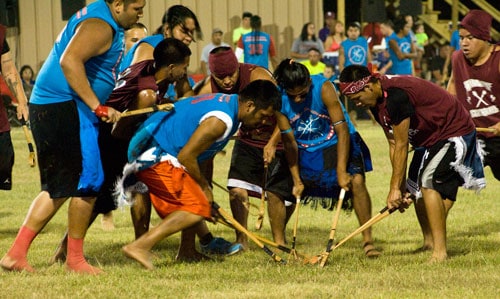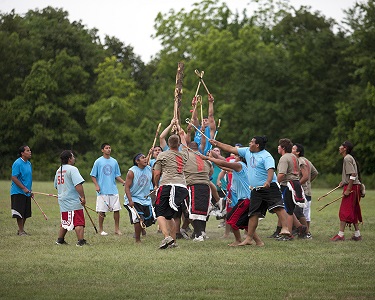Indigenous North American Stickball In the vast tapestry of Native American heritage, one traditional game stands out as a symbol of unity, culture, and resilience—stickball. This ancient sport, often played with fervor and spirit, has been immortalized in a Google Doodle, celebrating its significance during Native American Heritage Month. In this article, we’ll dive into the captivating world of stickball, exploring its roots, its significance, and why it deserves our attention today.
The Origin of Stickball: A Tale of Resilience
Stickball, a game deeply ingrained in the heritage of many Native American tribes, including the Choctaw and Cherokee, has a history as rich and vibrant as the cultures it represents.
Long before modern sports arenas and high-tech equipment, indigenous North American tribes engaged in stickball as a means of recreation, warfare, and community bonding. The game often featured prominently in tribal ceremonies, serving as a powerful symbol of strength and unity.
Why Is Google Celebrating Stickball?
Recently, Google Doodle celebrated the ancient sport of stickball, shedding light on its significance in Native American history.
Designed by Native American artist Marlena Myles, the Google Doodle beautifully encapsulated the essence of stickball. It’s a game played with two sticks and a single ball, rooted in tradition yet adaptable to various regions and communities. Myles’ artwork not only paid homage to the sport but also highlighted the cultural importance of stickball to many Native American tribes.
Google’s decision to celebrate Stickball with a dedicated Google Doodle is a recognition of the sport’s cultural and historical importance to Indigenous North American communities. It highlights the need to acknowledge and honor the rich heritage of these communities and the traditional sports that are often underrepresented in mainstream discourse.
The choice of Stickball as a subject for a Google Doodle is a step towards raising awareness about the cultural significance and resilience of Indigenous peoples. In a world where Indigenous voices and stories have often been marginalized or overlooked, the Google Doodle serves as a platform to share an important aspect of their heritage.
By celebrating Stickball, Google not only pays tribute to the sport but also emphasizes the importance of cultural diversity and understanding. It encourages individuals to learn more about Indigenous history and the significance of traditional sports in their communities. This celebration fosters a sense of inclusivity, fostering appreciation for the rich tapestry of cultures that make up North America.

Playing the Game:
Stickball, like many traditional games, is not bound by rigid rules but thrives on the spirit of the players.
While stickball can vary in its rules and style from tribe to tribe, it generally involves two teams competing to score goals by getting a ball through a designated area. Players use sticks to carry, pass, and shoot the ball, showcasing their agility and teamwork.
Also Visit: What is Fapello: Watch Latest Onlyfans Leaked Videos And Images
The Evolution of Stickball:
Stickball has evolved over time, adapting to the changing world while preserving its cultural significance.
In the modern era, stickball has continued to thrive, albeit with some modifications. Today, it’s played as a community event, bringing people together and fostering a sense of belonging. The game has even made its mark on the sports world, influencing the development of lacrosse, another team sport with indigenous origins.

The Ceremonial Aspect of Stickball
Beyond its role as a sport, stickball holds deep cultural and ceremonial importance.
Many tribes still incorporate stickball into their rituals and festivals. It serves as a reminder of their ancestors’ resilience and a way to pass down traditions to the younger generations. The imagery associated with the game often holds spiritual significance, further emphasizing its ceremonial role.
Read For More: Who is Barbara May Cameron? Why Google Celebrating Her 69th Birth Anniversary
Conclusion:
In a world filled with sports and entertainment options, stickball stands out as a unique and powerful testament to the rich tapestry of Native American culture. It’s a game that has transcended time, preserving its essence while adapting to the modern era. As we celebrate Native American Heritage Month, let us remember the game of stickball, a symbol of unity, resilience, and the enduring spirit of indigenous peoples. Visit Sensepot
FAQ’s:
Q1: Why did Native Americans play stickball?
Native Americans played stickball for a variety of reasons, including fostering unity among tribes, settling disputes, and celebrating their cultural heritage. It served as both a sport and a means of maintaining tribal connections.
Q2: Which Native American tribe played stickball?
Many Native American tribes played stickball, with variations in rules and traditions. The Cherokee, Choctaw, and Creek tribes are among those known for their historical involvement in the sport.
Q3: What is the Native American game with sticks?
The Native American game involving sticks is commonly known as “stickball.” It’s a traditional sport with deep cultural and spiritual significance in various Indigenous communities.
Q4: Where did stickball originate from?
Stickball is believed to have originated from the Southeastern United States, with different tribes in the region developing their own unique variations of the game.


